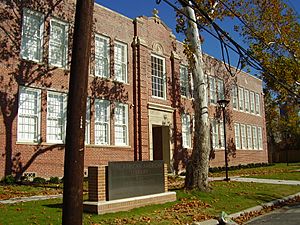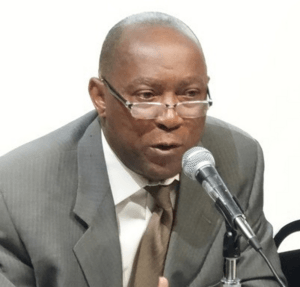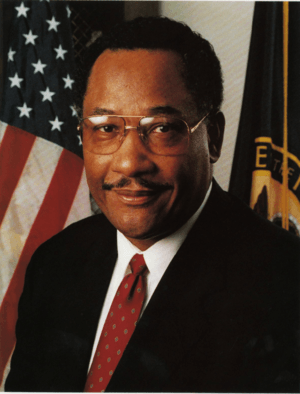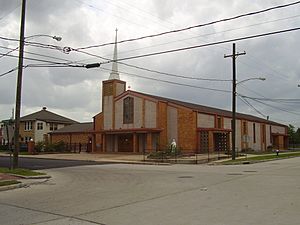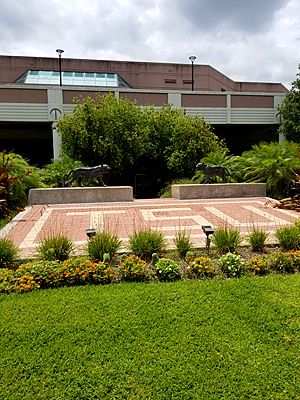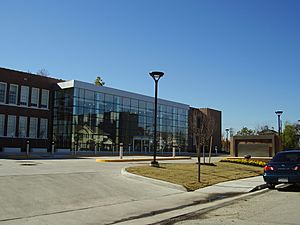History of African Americans in Houston facts for kids
The African American population in Houston, Texas has been an important part of the city since it began. The Houston area has the largest number of African Americans in Texas. It also has the largest number west of the Mississippi River. Because of this, Houston is sometimes called a "black mecca."
Contents
History of African Americans in Houston
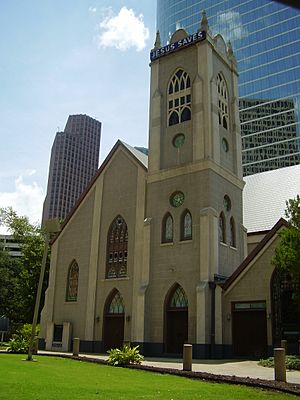
When Houston was founded in 1836, an African American community was already growing. In 1860, many African Americans in the city were enslaved. Some were free, but most were slaves. Before the American Civil War, enslaved African Americans worked on farms outside the city. Those in the city worked in homes or as skilled workers.
Slavery ended after the Civil War. But by the 1870s, racial segregation became law across the South, including Texas. This meant Black people and White people were kept separate. African Americans in Houston had little say in politics. White leaders used different ways to keep control.
The Houston riot of 1917 was a conflict involving Black U.S. soldiers stationed in Houston.
In 1929, a city planner suggested dividing Houston by race. This idea was to keep African Americans from living too close to White communities. But the city never made this a law.
In the 1940s and 1950s, many Black people moved to Houston from smaller towns. This made the Black communities grow. White people started moving out of areas like the Third Ward. This happened partly after the Brown v. Board of Education decision in 1954. This decision said that separate schools for Black and White children were not fair.
Civil Rights and Desegregation
Students from Texas Southern University helped lead the effort to end segregation in Houston in the 1960s. On March 4, 1960, these students held Houston's first sit-in. They sat at a lunch counter in a Weingarten's grocery store. This sit-in helped end segregation in many White-owned businesses in Houston.
Six months after this first sit-in, 70 lunch counters in Houston were desegregated. Their continued efforts helped all businesses in the city become integrated.
In 1970, most Black people in Houston lived in mostly African American neighborhoods. By 1980, this number went down a bit.
Historically, Houston placed city landfills in African American neighborhoods. Private companies also put landfills there. Between the 1920s and 1970s, most city landfills and incinerators were in Black neighborhoods. During this time, African Americans were about 25% of the city's population. The city council, which decided where landfills went, was all White until 1972. Efforts by activists led to changes. This stopped the practice of placing landfills only in Black neighborhoods.
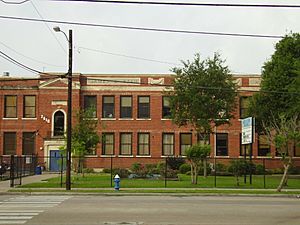
By 1980, Houston had over 440,000 African American residents. This made it one of the largest Black populations in the country. Even though Black people could legally move anywhere, many stayed in their old neighborhoods. This was often because they wanted to live where they grew up.
From 1980 to 1990, many African Americans moved from older neighborhoods. These included areas like the Third Ward and Sunnyside. They moved to parts of Southwest Houston, like Alief and Sharpstown. At the same time, many White families moved from the city to the suburbs. This was called "white flight."
In 2004, some African Americans who had moved to the suburbs returned to the inner city. They still felt connected to those communities.
By 2005, Black people continued to move from older neighborhoods. They moved to areas like Alief, Missouri City, and other suburbs. In many traditional Black neighborhoods, Mexican and Latino residents moved in. Today, many African Americans are moving to Houston. They come for the lower cost of living and more job opportunities. Houston gained about 233,000 African Americans between 2000 and 2010. Houston is now known as a major center for African American culture and power. It is often called a "black mecca."
After Hurricane Katrina in 2005, many Black people from New Orleans moved to Houston. Many of them decided to stay.
Commerce and Business
The African American community in Houston has a rich history of business. Many businesses grew in areas like the Third, Fourth, and Fifth Wards. These included restaurants, theaters, clubs, and shops. There were also banks, insurance companies, and tailors.
Two major buildings, the Pilgrims Building and the Odd Fellows Building, housed many Black-owned businesses. Farmers and ranchers were also important. The Taylor-Stevenson Ranch, still owned by the original family, was once home to Sky Ranch. This was an airport started by Tuskegee Airmen in the mid-1900s.
In the early 1900s, the community celebrated "DeRoLoc." This event promoted local businesses. It included an exhibition, a ball, and a carnival. The first DeRoLoc event in Emancipation Park hosted 4,000 people. This event stopped in 1929 but has recently been brought back. In the Acres Homes area, there was the first African American Bus Company. It provided transportation for many African Americans to downtown Houston.
Cuisine and Food
Many Louisiana Creole people moved to Houston around the 1920s. They brought their unique cooking style with them. Creole and Cajun food became popular in Houston after World War II. This led to famous Creole food chains like Frenchy's Chicken and Popeyes. Popular Creole dishes include gumbo, jambalaya, and crawfish. One author noted that Creole cooking helped connect different parts of Houston's African American community.
In 2021, a food critic wrote that hamburger restaurants in Houston's Black neighborhoods often cook hamburgers "exceptionally charred and well-done."
In 2020, many of the vegan restaurants in Houston were owned by African Americans.
Demographics and Population
From the 1870s to the 1890s, African Americans made up almost 40% of Houston's population. Between 1910 and 1970, their population ranged from 21% to 32.7%.
In 1870, most African Americans lived in the Fourth Ward, Third Ward, and Fifth Ward. By 1910, the Third Ward had the largest group.
In the 1920s, there were about 34,000 African Americans in Houston. By the 1930s, this number grew to about 63,000. In the segregation era, people of Louisiana Creole origin with African heritage attended Black schools. They often saw themselves as different from other African Americans. Creoles spoke Louisiana Creole French and had their own music style.
In 1940, the African American population was over 86,000. This was 21.4% of Houston's total population. By 1950, it grew to over 125,000. Most of this growth was from African Americans moving from other parts of the United States, especially Louisiana and Texas. In 1960, the African American population was over 215,000, making up 25.7% of the city. Their percentage grew because many White people left the central city. By 1980, Houston had over 440,000 African American residents.
In 2004, 55% of African Americans in Harris County were born in the Houston area or grew up there.
Between 2010 and 2015, Houston added about 100,000 new Black residents. This was one of the largest increases in the nation. Many African Americans are moving to Houston because of its strong and influential Black community.
The Houston area has the largest African American community in Texas. It is also one of the top 10 in the United States.
Cultural Institutions
Houston has several important cultural places for African Americans:
- The Houston Museum of African American Culture (HMAAC) is in the Houston Museum District.
- The Buffalo Soldier National Museum is also in the Museum District.
- The Community Artists' Collective in Midtown is a place for Black artists.
- The University Museum at Texas Southern University shows art by and about people from the African diaspora.
- The Rutherford B. H. Yates Museum helps preserve the history of African Americans in Houston's Freedmen's Town.
- Shrine of the Black Madonna is a cultural center, museum, and bookstore.
- The Houston Black Chamber of Commerce supports Black businesses and professionals.
Politics and Leadership
Lee P. Brown was elected in 1997. He was the first Black Mayor of Houston. He was the city's 50th mayor.
In 1997, African Americans usually made up less than 25% of Houston's voters. But for Lee P. Brown's election, they may have been over 33% of the voters. Brown won more than 90% of the votes in African American neighborhoods.
As of 2005, Sheila Jackson Lee and Al Green were two Black Texans in the United States House of Representatives. Both are from Houston.
On December 13, 2015, Houston elected its second African American mayor, Sylvester Turner.
Religion and Churches
The number of African American Catholics in Houston grew after the Great Mississippi Flood of 1927. Many moved to the Fifth Ward. In the 1930s, the Catholic church became more popular with African Americans. This was partly because they felt it treated them better than some Protestant churches.
Trinity United Methodist Church is the oldest Black church in Houston. It was started by Rev. Elias Dibble.
The oldest Black Baptist church in Houston is the Antioch Missionary Baptist Church. It is in the historic Freedmen's Town of the Fourth Ward. Jack Yates was once a pastor there.
Houston's first Black Catholic church was St. Nicholas in the Third Ward. The Our Mother of Mercy Catholic Church in the Fifth Ward was the second. It opened in 1929. Black Catholic churches in Houston sometimes include Louisiana Creole culture, like zydeco parties.
Before Our Mother of Mercy was built, some Louisiana Creole people went to the Hispanic Our Lady of Guadalupe Church. It was the closest church to the Frenchtown area. But the Creole people felt they were treated unfairly there. They were made to confess and take communion after others. They also had to sit in the back pews. So, the Creoles decided to build their own church.
St. Anne de Beaupre in Sunset Heights is Houston's third Black Catholic church. It opened in 1938. Its name comes from a French-speaking Canadian site. This shows the Louisiana Creole culture.
Media and News
The Houston Forward Times started in 1960. It is the largest Black-owned newspaper in Houston. The Houston Defender and the African-American News and Issues are other well-known Black-owned papers. The Texas Freeman began in 1893. It later joined with The Houston Informer to become The Houston Informer and Texas Freeman.
KCOH 1430 AM was a Black-owned radio station that started in 1953. It was a central point for Houston's Black community. It was located at the famous "looking-glass" studios on Almeda in Midtown Houston. KCOH helped start the careers of many radio personalities. The station was sold in 2012.
The Houston Sun was started by Dorris Ellis and Lonal Robinson in 1983. It has won many awards. It also holds an annual conference for high school and college journalism students.
Education and Schools
Texas Southern University (TSU) is the largest HBCU (Historically Black College or University) in Texas. It is the only HBCU in Houston. Prairie View A&M University is near Houston. It is the second largest HBCU and the second oldest public university in Texas.
Historically Black high schools in Houston (schools for Black students before desegregation) include:
Historically Black middle schools included:
- Ryan Middle School (closed in 2013)
The Imani School is a private school for African American families.
History of K-12 Education
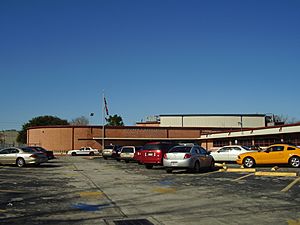
After the U.S. Civil War, "Freedmen's schools" opened for Black children. Later, the Gregory Institute, a private school, opened in the Fourth Ward.
In 1892, Colored High School opened. It was the first high school for Black students. In the 1924–1925 school year, there were over 8,000 Black students in Houston's schools. In 1925, the Houston school board announced a new high school would open in the Third Ward. This was because the Black population had grown a lot.
With new schools like the former Jack Yates High School (later Ryan Middle School) and Wheatley High School, the number of spots in high schools for Black children tripled from 1924 to 1929. The original Colored High School became Booker T. Washington High School. At that time, all three high schools had both junior high and senior high levels. In the 1929–1930 school year, there were over 12,000 students in the Black schools. Conditions in Black schools "improved dramatically" in the 1920s.
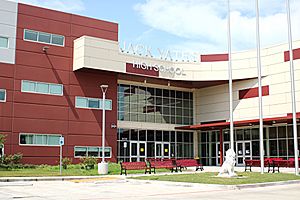
On January 27, 1958, Worthing High School opened. This helped ease crowding at Yates. Yates moved to its current location in September 1958. Yates's old site became Ryan Colored Junior High School (now Ryan Middle School). It was named after Yates's first principal. Booker T. Washington moved to its current location in Independence Heights in 1959.
In the Fort Bend Independent School District (FBISD), M.R. Wood School was one of three schools for Black students. It was the only Black high school until the district ended segregation in 1965.
Racial desegregation of the Houston Independent School District (HISD) happened in the 1970s. This was due to the Civil Rights Movement. Yates High School began to lose students from wealthier families. This was because they moved to the suburbs or went to magnet schools. As a result, Yates began to decline. Wheatley also lost students and teachers after integration.
Public Libraries
The Houston Public Library has the African American Library at the Gregory School. This library keeps historical information about Houston's African American community. It is the city's first library focused on African American history and culture.
The W.L.D. Johnson Neighborhood Library is another important library.
Culture and Recreation
Ensemble Theatre
The Ensemble Theatre, an African American theater company, is in Midtown. The theater started in 1976. It is the largest African American theater company in the United States.
Juneteenth Celebration
Juneteenth is a yearly celebration. It remembers the day Black slaves in Texas were freed. President Lincoln signed the Emancipation Proclamation in 1863. But the news did not reach Galveston, Texas, until June 19, 1865. Over the next few years, African Americans in Texas raised money to buy land for Juneteenth celebrations. In Houston, Reverend Jack Yates led this effort. His church, Antioch Baptist, and Trinity Methodist Episcopal Church bought ten acres of land in 1872. They named it Emancipation Park to honor their freedom.
Many events happen in Houston to celebrate Juneteenth. The Friends of Emancipation Park (FEP) is a group that works to protect the park's history. FEP helped with a $33 million project to fix up Emancipation Park. The park is in the Third Ward. It is a popular place for Juneteenth celebrations.
Texas made Juneteenth a state holiday after Al Edwards, a Houston politician, suggested it.
Martin Luther King Day Parades
Houston has two different Martin Luther King Day parades each year. The MLK Grande Parade is held by the MLK Parade Foundation. The Original MLK Birthday Parade is held by the Black Heritage Society. These two parades used to compete for the best time and day.
In 2007, a judge allowed both parades to happen in Downtown Houston. By 2008, a rule was put back in place. It said only one parade could be held downtown on a specific day. The day was decided by a coin toss.
The Houston Press called the 2006 MLK day parade the "Best Parade Houston 2006." That year, the two rival parades joined together.
Service projects and voter registration drives also happen on MLK Day in Houston.
Black Heritage Day at Houston Rodeo
Every spring, the Houston Livestock Show and Rodeo has a special day. It celebrates Black culture. A different popular Black music artist performs at the event each year.
Houston Hip Hop Music
The Houston hip hop music scene is very important. It has a unique sound that is known around the world.
Texas Southern–Prairie View Rivalry
The sports games between Texas Southern University and Prairie View A&M University are very popular. Many African Americans in Houston attend these events. The Labor Day Classic is the only HBCU football classic in the Houston area. Basketball games in the winter also draw large crowds.
National Battle of the Bands
Since 2019, Houston has hosted the second largest college marching band event in the nation. Each year, over 40,000 fans come to NRG Stadium. They watch several HBCU band programs perform. This event also helps raise money for the bands.
Houston Black Restaurant Week
Houston is famous for its great restaurants. Black-owned restaurants are a big part of this. For two weeks every year, many Black-owned restaurants and chefs take part in this event. It highlights their contributions to the city's food scene.
Black Gay Pride
Houston's Black LGBT community celebrates its presence each year with an event called "Splash." This event organizes activities for gay, lesbian, and transgender people of African descent. It aims to improve their cultural, health, and social well-being. It is the oldest Black gay event in Texas.
Cemeteries
Humble Negro Cemetery is in the suburb of Humble.
Notable people from Houston
- Phylicia Rashad – actress
- Quanell X (Quanell Ralph Evans) – leader of the New Black Panther Nation
- Debbie Allen – actress
- Beyoncé (Beyoncé Giselle Knowles-Carter) – singer, songwriter, and actress
- Kelly (Kelendria Trene Rowland-Witherspoon) – singer, songwriter, and actress
- Solange – singer, songwriter, and actress
- Mathew Knowles – music manager and educator
- LeToya Luckett – singer, songwriter, and actress
- Megan Thee Stallion – rapper
- Trae tha Truth – rapper
- Scarface – rapper
- H-town – R&B group
- Ideal – R&B group
- Isiah Washington – actor
- Simone Biles – gymnast
- Brittney Griner – basketball player
- Michael Strahan – athlete and TV personality
- Yolanda Adams – singer
- Christia Adair – Civil rights activist
- Richard Allen – politician
- Michael Arceneaux – author
- Slim Thug – rapper and entrepreneur
- Mike Jones – rapper and entrepreneur
- Kirko Bangz – rapper
- Lee P. Brown – former mayor of Houston
- Robert D. Bullard – sociologist
- Kirbyjon Caldwell – pastor
- Chamillionaire (Hakeem Seriki) – rapper
- Percy Creuzot – founder of Frenchy's Chicken
- Ruth Simmons – academic
- Loretta Devine – actress
- Detria Marie Ward – actress
- J. E. Franklin – playwright
- Timothy Eric Dixion – actor
- Jennifer Holliday – actress, singer
- Rodney Ellis – politician
- Fat Tony (Anthony Obi) – rapper
- George Foreman – Olympic Gold medalist, boxer, and entrepreneur
- Van G. Garrett – poet
- Lightnin' Hopkins (Sam John Hopkins) – musician
- Lenwood Johnson – activist
- Vince Young – former NFL player
- Rashard Lewis – former NBA player
- Barbara Jordan – Congresswoman
- Elwyn Lee – University of Houston administrator
- Sheila Jackson Lee – Congresswoman
- Mickey Leland – Congressman
- Thaddeus S. Lott Sr. – school principal
- Rod Paige – former Houston ISD superintendent and U.S. Secretary of Education
- Dr. Anthony B. Pinn – professor
- James Prince – CEO of Rap-a-Lot Records
- Monica Roberts – activist
- Sylvester Turner – current mayor of Houston
- Jack Yates – pastor and activist
- Roland S. Martin – journalist
- George Floyd – former rapper and a Black man whose death sparked protests.


